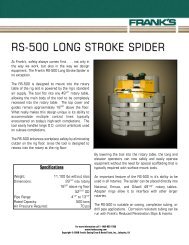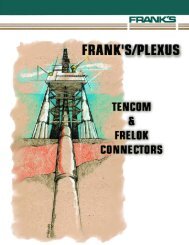Master Mag Templet - Frank's International, Inc.
Master Mag Templet - Frank's International, Inc.
Master Mag Templet - Frank's International, Inc.
Create successful ePaper yourself
Turn your PDF publications into a flip-book with our unique Google optimized e-Paper software.
Along with many Americans, many French felt that an<br />
important symbol of freedom was lost. After all, Abraham<br />
Lincoln had been fundamental in freeing the slaves.<br />
So the people of France collected money to buy a gift<br />
for Lincoln’s widow. Each contributor was limited to a<br />
two-cent donation. Together, they purchased a gold medal<br />
inscribed: “Tell Mrs. Lincoln that in this little box is the<br />
heart of France.” Then, in French, the inscription read:<br />
“Dedicated by French democracy to Lincoln, twice-elected<br />
President of the United States – honest Lincoln who abolished<br />
slavery, re-established the union, and saved the<br />
Republic, without veiling the Statue of Liberty.”<br />
The Dream Is Born<br />
That passion for freedom<br />
shared by America and<br />
France deeply impressed<br />
one of de Laboulaye’s<br />
guests at that summer dinner<br />
party – a young sculptor<br />
from Alsace named Frederic<br />
Auguste Bartholdi. The talk<br />
that night amongst the<br />
guests, all prominent in arts<br />
and letters like himself,<br />
Frederic Auguste Bartholdi would soon have special<br />
resonance for young Bartholdi.<br />
The conversation turned to topics global in scope, as<br />
it often did at de Laboulaye’s soirees, and particularly to<br />
the notion of international gratitude. Some of the guests<br />
said there was no such thing. Nations, they argued, fend for<br />
themselves, and even the closest of countries will separate<br />
as soon as one’s self interest conflicts with the other’s.<br />
But de Laboulaye disagreed, calling the bond between<br />
France and the United States special and unbreakable.<br />
Indeed, he said, his land should even consider some sort<br />
of monument to commemorate American independence –<br />
a monument constructed by the two nations together.<br />
Those words would swirl in the young sculptor’s head as<br />
he fought in the French army during the Franco-Prussian<br />
War. When the war ended and his homeland remained in<br />
enemy hands, he considered emigrating to America and<br />
adopting it as his new home. In doubt about his future<br />
and about the ties of two nations, he sought counsel from<br />
de Laboulaye once again – and again left the meeting<br />
imbued with the belief that ties between countries can<br />
be strong. He suggested that Bartholdi travel to America<br />
to see for himself and examine the possibility of some<br />
sort of joint project to demonstrate the friendship between<br />
the two lands.<br />
“Here at our sea-washed, sunset gates shall stand a mighty woman...”<br />
— Emma Lazarus<br />
An Inspired Location<br />
Like Francis Scott Key so many years earlier, the site of an<br />
American harbor inspired what would become an artist’s<br />
greatest triumph. As his ship entered New York Harbor, he<br />
knew what the monument should be and where it should<br />
forever stand as an emblem of the special friendship the<br />
two countries shared.<br />
His vision would not be lost to the poet Emma Lazarus. In<br />
1883, she wrote these immortal words:<br />
Not like the brazen giant of Greek fame, with conquering<br />
limbs astride from land to land; here at our sea-washed,<br />
sunset gates shall stand a mighty woman with a torch, whose<br />
flame is the imprisoned lightning, and her name Mother of<br />
Exiles. From her beacon-hand glows worldwide welcome;<br />
her mild eyes command the air-bridged harbor that twin<br />
cities frame. “Keep ancient lands, your storied pomp!” cries<br />
she with silent lips. “Give me your tired, your poor, your<br />
huddled masses yearning to breathe free, the wretched refuse<br />
of your teeming shore. Send these, the homeless, tempest-tost<br />
to me, I lift my lamp beside the golden door!”<br />
Finding Funds<br />
Her words captured for the ages the symbols of freedom that<br />
Bartholdi’s sculpture sought to portray. At the statue’s feet lie<br />
the broken shackles of tyranny. The Lady’s tablet, as every<br />
schoolchild knows, is inscribed “July 4, 1776.” And her<br />
torch, held proudly aloft in her right hand, serves as a beacon<br />
for all who seek freedom on our shores.<br />
Interestingly, the statue may never have come to be had it not<br />
been for the efforts of the famous newspaper editor Joseph<br />
Pulitzer. When he took over the New York World in 1883, he<br />
made it his mission to raise the funds for a suitable base for<br />
the statue. He struggled for years to raise both the public’s<br />
19

















